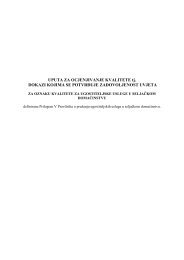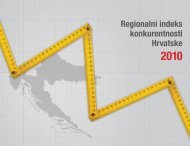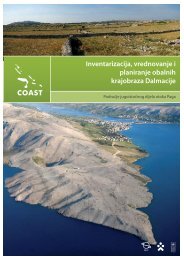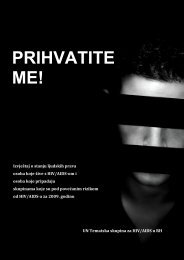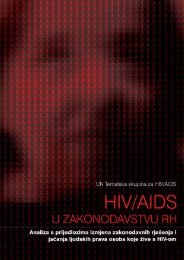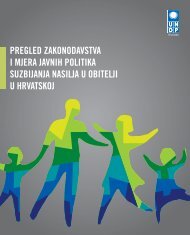THE SOCIALLY EXCLUDEDCHAPTER 3more trust in others than members of other agegroups, 119 and are more likely to change fri<strong>end</strong>s butwithin a similar social group that reflects their ownviews. Youth are generally very involved in varioushobbies, sporting activities, cultural programmes andother activities in their free time.3.8.9 Key ChallengesAlthough young people t<strong>end</strong> to express satisfactionwith their standard of living 120 it is likely that the youthwill continue to be in an unfavourable position in thelabour market in the near future. The current measuresaimed at youth employment have not been successfulor have yielded only negligible results. In order to finda solution it will be necessary to mobilise the Governmentat all levels and all social partners. At the globallevel, youth are recognized as “key participants in decision-makingand development”. 121 This partnershipcooperation is a model of inclusion for young peoplewhere they themselves identify problems and suggestsolutions and possible mechanisms.The active participation of youth in society is relativelylow. Some surveys show that less than 10% of youngpeople are involved in an organisation, which is mostfrequently a youth association. 122 Young women takea more active role in civil society than young men andare more inclined towards volunteering for the communitybenefit.A fairly small number of young people take part in theyouth branches of political parties. In general, youthdo not demonstrate an interest nor are they ready toactively participate in politics and consequently haveless representation in all levels of government. Forinstance, in the <strong>Croatia</strong>n Parliament there is only oneyoung person or 1% of the total number of parliamentarians.The situation is slightly better at the lowerlevels of government (municipalities and towns),but youth are still politically marginalized in <strong>Croatia</strong>.Although it is precisely the young people from theyouth branches of political parties who should havean active impact on the decision-making process,their senior colleagues t<strong>end</strong> to restrict their activities.Almost 2/3 of citizens agree that there is tension betweenyoung people and the older generation. 123 Thegreatest responsibility however lies with the youth toget actively involved in political life, since this is theonly way that they impact decisions primarily concerningyouth. For greater political activation, youngpeople need to develop a greater degree of identityas a social group, and as the relevant subjects whorepresent youth in public and political life. In youthassociations, an umbrella organisation called the<strong>Croatia</strong>n Youth Network has been created, whichincludes 48 organisations, including all major youthassociations. However, the Network is still not publiclyrecognised as an organization that representsthe interests of youth.In terms of participation in political parties, thegoverning elite does not provide much opportunityfor the advancement of younger generations. Evenafter adopting the National Programme of Action forYouth as the first strategy for youth in <strong>Croatia</strong>, it tookthree years for the systematic implementation of theNational Programme, according to the Operative Planfor 2006. The state institution in charge of the youthpolicy is the Ministry of the Family, Veterans’ Affairsand Intergenerational Solidarity. Within the Ministry isthe Family Directorate and the Department for Childrenand Youth, within which there is the Section for Youth,whose several members are responsible for the needsof 900,000 <strong>Croatia</strong>n citizens. This structure is an exampleof the contemporary view of youth as a case for socialwelfare as opposed to a potential social resource.In the 2006 state budget, the Ministry of the Family,Veterans’ Affairs and Intergenerational Solidarity allocated11 million HRK for youth policy and programmes,which is viewed by youth organizations as a hugesuccess. However compared to the total ministerial119 <strong>UNDP</strong> (2006a)120 <strong>UNDP</strong> (2006a)121 “Youth and the Millenium Goals: Challenges and opportunities for implementation”, Sustainable Development Commission of theUnited Nations, 2005, http://www.takingitglobal.org/themes/mdg/pdf/YouthMDG.pdf122 Youth on the Eve of the Third Millennium, , Institute for Social Research in Zagreb and the StateInstitute for the Protection of the Family, Maternity and Youth, Zagreb, 2002.123 The percentage of 24.4 interviewees hold that there is a lot of tension, and 48.6% of interviewees hold that there is little pensionbetween the old and the young. (<strong>UNDP</strong> (2006) “Research on social exclusion in <strong>Croatia</strong>: Groups with increased risk of social exclusion- focus groups”. <strong>UNDP</strong>, Zagreb, <strong>Croatia</strong>87
CHAPTER 3THE SOCIALLY EXCLUDEDbudget of 6.6 billion HRK, of which 4 billion is allocatedto veterans, the amount allocated for youth pales incomparison. According to the Operative Plan of the NationalProgramme of Action for Youth, the governmenthas budgeted additional 40 million HRK to 7 ministriesand two state offices, for the realisation of 40 prioritymeasures defined in the National Programme.3.8.10 Policy ImplicationsConsidering that the current situation for youth hasnot improved significantly over the past several years,many of the following recomm<strong>end</strong>ations can befound in other publications, especially those concerningyouth policy, such as the National Programme ofAction for Youth or the 2004 National Human DevelopmentReport for <strong>Croatia</strong>, committed to youth. Althoughthe youth sector has developed considerably in thepast 5 years, the government still has to recognizeyouth as a priority. Without this, any implementation ofindividual measures in a national or local programmewill be unstructured and ineffective.The <strong>Croatia</strong>n Government should develop and adopta comprehensive strategy for youth employment aswell as incentives for solving the housing problem foryoung people. The state administration and regionaland local authorities should embrace the principleof “co-management” in all bodies concerning youth.This particularly relates to the <strong>Croatia</strong>n GovernmentYouth Council that should promote equal participationof young people in its work. All levels of governmentshould develop projects of multiregional andmultifunctional youth centres in partnership withyoung people.Youth organisations should be more active and energeticin the implementation of programmes involvingyoung people aiming to increase the active participationof young people in society. They should also enterinto networks at the local level and, through theiractivities and engagement, impose themselves as anequal partner in the co-creation of youth policy.3.9 Prisoners3.9.1. Human RightsThe law prohibits discrimination against inmateson any grounds - regardless of their race, g<strong>end</strong>er,language, religion, political beliefs, national or socialorigin, education, social position or other characteristics.Imprisonment means only the deprivation ofliberty, and as such, conditions and procedures usedin connection with inmates should not include anyadditional forms of punishment. Inmates, althoughguilty of criminal actions, are still citizens of <strong>Croatia</strong>and should not be subject to the risk of physical oremotional abuse. A large portion of the public believethat inmates should not be provided with specialcare or comfortable conditions, given that many lawabiding citizens struggle with their quality of life andunemployment. “It is said that no-one truly knowsa nation until one has been inside its jails. A nationshould not be judged by how it treats its highestcitizens, but its lowest ones.” 124The level of social exclusion inmates will suffer t<strong>end</strong>sto be proportional to the duration of their sentences.Although inmates who are in the prison system for ayear or less adjust to society relatively quickly, theymay still experience exclusion in the loss of theirprevious employment, social contacts, emotionalconnections, and family communities. About onethirdof inmates are in prison for one to three yearsentences. Prison sentences longer than five years aremostly served in prison penitentiaries. Research hasshown that during sentences that exceed five years,a mutual process of separation occurs where inmateslose their sense of belonging to a wider social community,and embrace the prison community.The inmate demographic is a microcosm of society,containing various groups, some of which are especiallyvulnerable. These groups include the elderly,the disabled, people with mental disabilities, addicts,foreigners, illiterates and members of national minorities.Even within each of these groups, there are88124 Mandela N. (1994), Long Walk To Freedom, Little Brown, London.



